Mabel Albertson, born in Haverhill, appeared on “Bewitched” as Phyllis Stephens, Samantha’s headache prone mother-in-law.
By Dave Goudsward
Special to WHAV News
If you look me up on IMDB, you’ll see I have a handful of television credits. Not listed (and rightfully so), is my sole movie appearance back in 1994 as an extra in the stadium for Florida spring training scenes of “Major League II.” Filmed in Harrisburg, Penn.’s minor league stadium. Instead of looking for me, I suggest looking for the one lonely palm tree the crew brought. Every time they moved the camera angle, they had to move the palm tree first – because it was supposed to be Florida! If the spring training scenes were any longer, that tree would qualify for a co-star credit. The experience, especially wearing a short-sleeved tropical shirt in March in a “Florida stadium” on an island in the still ice-choked Susquehanna River, was a horror story, but alas, a horrific afternoon fighting off hypothermia does not make the film a “horror film.”
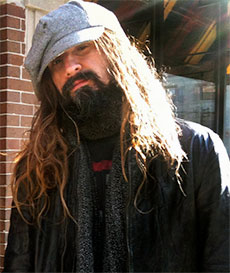
Rob Zombie in_2009. (Eric Thirteen photograph, Creative Commons.)
The only horror filmed in Haverhill is “God of Vampires” (2010). Hired killer Frank Ng (Dharma Lim) has been contracted to murder a rival crime lord. Unfortunately, Frank was not told the crime lord is a kiang-shi, the legendary Chinese vampire. Now Frank and an unlikely team of vampire hunters must enter the crumbling urban lair of the creature to destroy the monster. Those vampire lair scenes were shot in the cavernous cellars of the Essex Associates Building at Locke and Essex Streets. Built in 1915 as part of the burgeoning shoe industry, by the 1980s, the shoe industry was long gone and the building was a battered and neglected industrial derelict. You won’t recognize the location today – the converted Hamel Mills Lofts are a far cry from the scenes shot in the decrepit basements prior to renovation. Sharp-eyed viewers might also recognize the former Grand China Restaurant off Route 28 in Salem, N.H. Indie film budgets being what they are, the venerable Grand China was used as a stand-in for a Boston Chinatown venue. The fact that leading man Dharma Lim’s family owned the restaurant didn’t hurt either.
Rather than at city locations, it is in the casts and crews of films that Haverhill’s impact in horror movies lie. And perhaps none have been as high profile as Bradford’s own Rob Zombie. The Haverhill High grad took his diploma and headed to New York, becoming a major force in heavy metal that infused references to the horror films he loved. Zombie subsequently expanded his horror-motif music career into film, writing and directing such films House of 1000 Corpses (2003), the 2005 sequel The Devil’s Rejects and the 2007 reworking of Halloween and its sequel. Zombie’s The Lords of Salem (2013) was set and partly filmed in Salem.
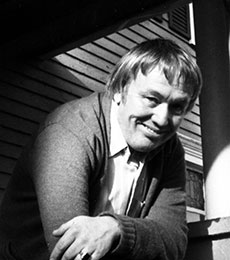
John Bellairs.
John Bellairs (1938-1991), buried in Rocks Village was an author of gothic supernatural novels for young adults. His “Johnny Dixon” series began with The Curse of the Blue Figurine (1983) and was set in Duston Heights, a thinly-veiled 1950s Haverhill. The Johnny Dixon series has yet to be adapted for the screen, but his other young heroes have appeared on television. When CBS Children’s Mystery Theatre premiered in 1980, the first live-action episode was Bellair’s “The Treasure of Alpheus T. Winterborn.” The next year Vincent Price narrated Once Upon a Midnight Scary, a CBS animated special that brought three stories to television in 1979—“The Ghost Belonged To Me,” “The Legend of Sleepy Hollow” and Bellair’s “The House With A Clock In Its Walls.” Currently, a full-length film version of The House With A Clock In Its Walls is in pre-production.
In the wake of the Great Fire of 1882, Haverhill’s shoe rebounded and grew, bringing a steady flow of immigrants to Haverhill. Some stayed and settled in town. Some quickly moved on to another job in another factory town. Among these transient workers were the Russian immigrants Leopold and Flora Albertson. In 1901, the newlyweds came to Haverhill for work but soon moved on. While living in Haverhill, Flora gave birth to their first child, Mabel Albertson. Albertson would move to New York and embark on a show business career that spanned 50 years. Her specialty was the judgmental and aloof relative, a genre in which she reached the apex on the TV series Bewitched as Phyllis Stephens, Samantha’s headache prone mother-in-law. In real life, she became the mother-in-law of Frau Blücher of Young Frankenstein (1974) when her son George Englund married actress Cloris Leachman. Her brother Jack Albertson, no slouch in the horror field either, was born in Malden six years later.
Forest Hill Cemetery in East Derry, N.H., was used to film Haverhill author Scott T. Goudsward’s screenplay for the short film Granite Voices (2002), the story of two teenage mediums that unwillingly allow restless spirits to air their final message.
Chandler Sprague (1886-1955) was born in Haverhill. He went to Los Angeles as a reporter but began to write for the studios. After a stint in the Army in World War II, he went back into journalism as editor of a USAF newspaper. His last story for Hollywood would become his legacy – the story would become the film “A Guy Named Joe” (1943), with Spencer Tracy as a dead World War II bomber pilot who serves as guardian angel of another pilot, both in combat and as a suitor for his old girlfriend, still in mourning far too long. It’s technically not horror, but it is a ghost story of sorts, as well as Sprague’s only nomination for an Oscar. It would be remade, ghost and all, in 1989 as “Always.”
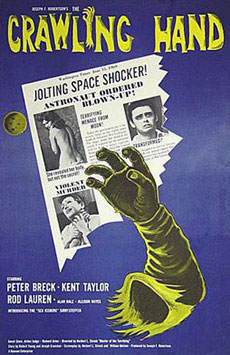 Peter Breck was born March 13, 1929, in Rochester. Because his father was a jazz musician often on the road, Peter lived with his grandparents George and Mary on Harvard Street in Haverhill, which his parents felt would offer him a more stable childhood. (George was a type composer for the Gazette). In 1937, Breck’s parent divorced and stability went out the window. Breck began traveling with his father. It inspired a love of travel that would prove helpful as he launched his career in theatrical touring companies. Once he arrived in Hollywood, he worked nonstop as a cowboy. As cowboys on television faded away, Breck branched out. In 1963, he appeared in an episode of “The Outer Limits” (1963) followed by the lead in “The Crawling Hand” as a scientist battling the (1963) animated hand of a dead astronaut that goes on a killing spree. Other appearances include the allegedly Lovecraft-based “The Unnamable II: The Statement of Randolph Carter” (1992) and an appearance on the revival of “The Outer Limits” (1996).
Peter Breck was born March 13, 1929, in Rochester. Because his father was a jazz musician often on the road, Peter lived with his grandparents George and Mary on Harvard Street in Haverhill, which his parents felt would offer him a more stable childhood. (George was a type composer for the Gazette). In 1937, Breck’s parent divorced and stability went out the window. Breck began traveling with his father. It inspired a love of travel that would prove helpful as he launched his career in theatrical touring companies. Once he arrived in Hollywood, he worked nonstop as a cowboy. As cowboys on television faded away, Breck branched out. In 1963, he appeared in an episode of “The Outer Limits” (1963) followed by the lead in “The Crawling Hand” as a scientist battling the (1963) animated hand of a dead astronaut that goes on a killing spree. Other appearances include the allegedly Lovecraft-based “The Unnamable II: The Statement of Randolph Carter” (1992) and an appearance on the revival of “The Outer Limits” (1996).
Bob Montana (1920-1975) was born in California and traveled with his show business parents. When Montana was 13, his father died of a heart attack, and his mother remarried. His new stepfather, John Carrol, had managed Hooker-Howe Costume Company in the 1920s and thought Haverhill would be a good choice to settle down and raise the family. They arrived in 1936. Montana kept a journal of his years in Haverhill High School (now City Hall), illustrating the entries with his cartoons. From this, Montana created Archie Andrews and his friends.
The Archie Comics empire introduced a new character in 1962, not a Montana creation. Sabrina Spellman, a teenage witch proved popular enough to get her own comic book. With the success of the Archie cartoons, Sabrina got her own animated series, which in turn spun off another animated icon of 60s-70s Saturday morning – “The Groovie Goolies.” Sabrina would return to animation in 1999 as a prequel to the live action series Sabrina the Teenage Witch, which also generated TV movies. Today, Montana would not recognize his creations – both Archie and Sabrina have new horror based comic book series. In September 2017, it was reported that a live-action television series, “The Chilling Adventures of Sabrina,” based on the Archie Horror imprint, is in development.
Joseph Ruskin (1924–2013) was a character actor who appeared on hundreds of television shows and dozens of movies. In fact, one of his first jobs in Hollywood was as an extra on Alfred Hitchcock Presents in 1958. He would appear again on the program later in his career as well as the revival in 1986. Although a perennial gangster and cowboy bad guy, he managed a few genre appearances on “The Outer Limits,” “Night Gallery,” and two episodes of “The Twilight Zone I,” including serving as the voice of Richard Kiel’s presumed alien benefactor in the classic episode “To Serve Man.”
His horror film credits include the comedies “The Munsters’ Revenge” (1981) and “Saturday the 14th Strikes Back” (1988). Other films include “King Cobra” (1999) and “Wishcraft” (2002), but his horror film highlight was “Diary of a Madman” (1963) with Vincent Price, playing the voice of the invisible demonic antagonist. Ruskin’s birth name was Joseph Richard Schlafman, and although his family moved from Haverhill while he was still a child, longtime residents will remember his relatives that stayed in town. His uncles Moses and Hymen were the Schlafman Brothers, the landmark newspaper and variety store on Washington Street, making him a first cousin to another legend of Haverhill’s recent past, Justice of the Peace and entrepreneur Leon S. Schlafman.
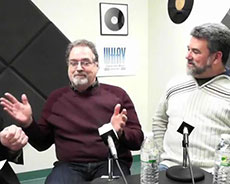
Christopher Golden, right, pictured with John M. McIlveen during a broadcast of WHAV’s Open Mike Show.
Christopher Golden is an award-winning, bestselling author whose bibliography includes 13 novels in the Buffy the Vampire Slayer universe, four non-fiction Buffy books, co-wrote both Buffy video games, and wrote or co-wrote numerous Buffy and Angel comics. With Amber Benson, he co-wrote the “Ghosts of Albion” animated web-series for the BBC. He co-wrote the screenplay for the new “Hellboy” movie due out next year.
Samuel “Sandy” Matlovsky (1921-2004) was a composer, predominantly known for background music for the Ivan Tors studios. He also was the composer for the psychological “Thriller Games” (1967) and conducted the studio orchestra for the adaptation of Ray Bradbury’s “The Illustrated Man” (1969) and the southern gothic “The Fool Killer” (1965). After his retirement, the 74-year old Matlovsky moved to Haverhill in 1995 and remained a resident until his death in 2004.
Lazar Meir was born in Dymer, Ukraine. His father, Jacob Meir, moved to Rhode Island, but years of anti-Semitism forced the family to move to Saint John, New Brunswick. Anti-Semitism was no better in Canada, but Lazar was now old enough to counter perceived slights with his fists. Dropping out after elementary school, he joined his father’s scrap metal business, leaving in 1904 for Boston, where the 19-year-old operated his own scrap metal business and began reinventing himself by changing his name to Louis B. Mayer (1885-1957). A year later, Mayer was married with a daughter and an incoming comfortable enough to consider investing in other businesses. In 1906, the family moved to Brooklyn briefly. Mayer couldn’t find an opportunity he liked. So, after the birth of his second daughter, they returned to Boston. Mayer left New York with an idea. The new hot business in New York was making motions pictures. Mayer thought the business had potential with little overhead. The studios in New York made the films, and other companies handled distribution. All Mayer needed was a venue to show films.
In Boston, he heard that there was a theater in Haverhill available. He leased then bought the run-down Gem Theater burlesque house on Essex Street (today, the building would be in the space across from the Hotel Whittier building). He spent three months renovating the theater, renaming it the New Orpheum to distance the operation from its seedy past. He also announced that the new theater would show only wholesome, high-quality films, this was also marketing but reflected his preferences throughout his career. The New Orpheum was indeed profitable, and Mayer moved his family to Haverhill as he quickly began purchasing theaters in the region, including all five theaters in Haverhill. By 1914, he was beginning to hit the point where he could no longer maintain a hands-on presence. He joined forces in 1914 with another theater owner, Nathan H. Gordon and his Olympia chain. The Gordon-Mayer Theatrical Company had one purpose – both Gordon and Mayer had discovered that their theaters were still at the mercy of the distributors as to the length of time of use, and which titles could be provided to the theaters. The Gordon-Mayer Theatrical Company solved that problem by becoming a distributor, and not just to their own properties. The next year, in 1914, the company scored a major coup by purchasing the exclusive New England distribution rights to D.W. Griffith’s The Birth of a Nation (1915). The film’s success quadrupled the investment in the rights. Both Mayer and Gordon cleared a profit that would be over $1 million each in today’s currency.
In 1916, Mayer moved to Los Angeles. One last part of the motion picture industry he had not tried beckoned to him – producing his own films. He sold off his theaters to finance the Louis B. Mayer Pictures Corporation. Mayer’s new studio made melodramas for a decade, and his success caught the eye of theater chain mogul Marcus Loew. Loew had purchased two film companies, Metro and Samuel Goldwyn, but couldn’t make them profitable. He made Mayer an offer and in 1924, Metro-Goldwyn-Mayer was born. Mayer built a reputation in the industry. MGM made big-budget films, with Mayer’s insistence on films that were both quality and upstanding. The success also allowed Mayer to cherry-pick stars for the specific projects, creating the studio system. This is why, for one example, for the last five years of his life (1925–1930), Lon Chaney worked exclusively under contract to MGM.
MGM never became as invested in horror films as Universal was, mostly due to Mayer’s preferences in films. But when MGM did make a horror film under Louis B Mayer, it was memorable. Among the films made under his reign were Lon Chaney’s “London After Midnight” (1927), Tod Browning’s “Freaks” (1932), “Mark of the Vampire” (1935), considered Bela Lugosi’s best vampire film, and “Dr. Jekyll and Mr. Hyde” (1941) with Spencer Tracy.
Mayer was forced out at MGM in 1951 amid declining profits. He died six years later. His daughter Irene, who as a child, lived in Haverhill with her family, would grow up to marry film producer David O. Selznick. As Irene Mayer Selznick, she would be as much a force to be reckoned with on Broadway as her father was in Hollywood. Among the Broadway plays she produced was “Bell, Book and Candle,” debuting in 1950 and starring Rex Harrison. When the story of a modern-day witch living in New York City’s Greenwich Village was made into a 1958 film with Kim Novak and James Stewart, it was Columbia pictures, not MGM, who produced and distributed the film.
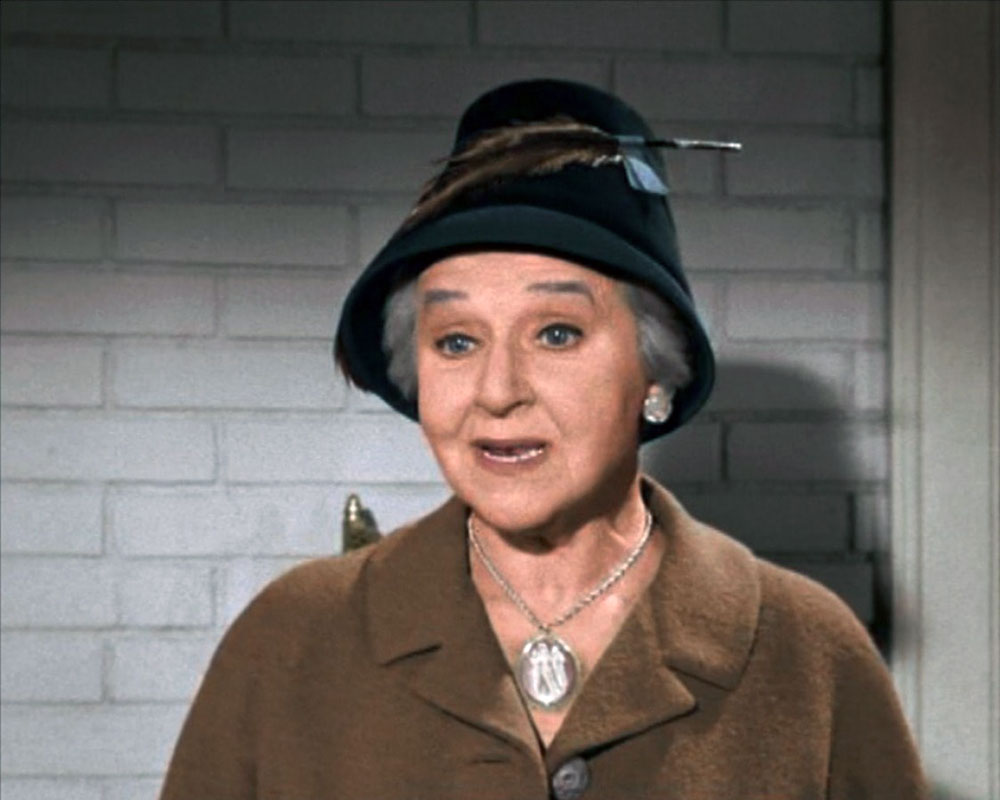

Fantastic article!!!!